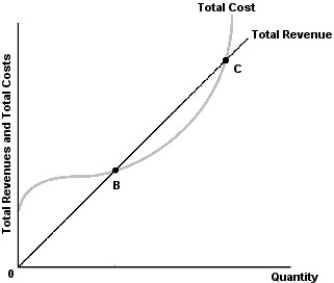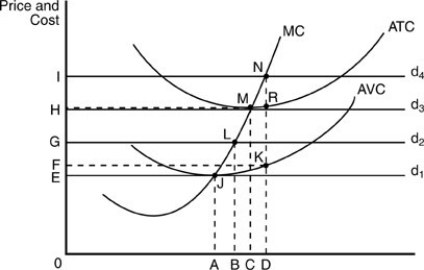A) are ways of conveying information.
B) are market noise that confuses buyers and sellers.
C) are best ignored by investors.
D) always lead to economic losses.
F) All of the above
Correct Answer

verified
Correct Answer
verified
Multiple Choice
 -Refer to the above figure. Profits for this firm are equal to zero
-Refer to the above figure. Profits for this firm are equal to zero
A) only for all points less than B.
B) only at points B and C.
C) for points between B and C.
D) for all points less than B and greater than C.
F) All of the above
Correct Answer

verified
Correct Answer
verified
Multiple Choice
What is the shape of the long-run supply curve in a constant-cost industry?
A) horizontal
B) vertical
C) downward sloping
D) upward sloping
F) C) and D)
Correct Answer

verified
Correct Answer
verified
Multiple Choice
 -Refer to the above table. This firm operates in a perfectly competitive market in which the market price is $10/unit. What is TRUE when the firm produces 103 units?
-Refer to the above table. This firm operates in a perfectly competitive market in which the market price is $10/unit. What is TRUE when the firm produces 103 units?
A) Total revenue equals $5,060.
B) Total costs exceed total revenue by $403.
C) Marginal revenue is less than marginal cost.
D) Its total profit is $524.
F) A) and B)
Correct Answer

verified
Correct Answer
verified
Multiple Choice
Which of the following statements is correct about the demand curve of the perfectly competitive industry?
A) The demand curve of the perfectly competitive industry is horizontal as are the demand curves facing the individual firms.
B) The market demand curve of perfect competition is vertical because the individual consumers are buying a homogeneous product.
C) The market demand curve of the perfectly competitive industry is downward sloping while the demand curve facing an individual firm is horizontal.
D) The market demand curve of the perfectly competitive industry is downward sloping, so the demand curves of the individual firms are also downward sloping.
F) None of the above
Correct Answer

verified
Correct Answer
verified
Multiple Choice
A farmer has many competitors and exists in a market structure known as perfect competition. This means that price is determined outside of the individual farmer's ability to charge a price higher than the going market for a bushel of wheat, hence the farmer is
A) a price maker and can therefore charge different customers different prices.
B) always able to price produce above the competition and earn a larger profit.
C) never able to determine any prices he charges for anything, such as soybeans.
D) a price taker and cannot affect the market price of wheat.
F) B) and C)
Correct Answer

verified
Correct Answer
verified
Multiple Choice
When price and marginal cost are equal for a perfectly competitive firm, the firm is
A) minimizing average total cost.
B) maximizing total revenue.
C) maximizing economic profit.
D) earning negative economic profit.
F) A) and C)
Correct Answer

verified
Correct Answer
verified
Multiple Choice
The perfectly competitive firm faces
A) a downward sloping demand curve.
B) a horizontal supply function.
C) perfectly elastic demand.
D) constant marginal costs.
F) B) and D)
Correct Answer

verified
Correct Answer
verified
Multiple Choice
Which of the following is always TRUE for a perfectly competitive firm?
A) P = d = MR
B) P = d = AVC
C) MC = MR = AVC
D) AVC = ATC = P
F) A) and C)
Correct Answer

verified
Correct Answer
verified
Multiple Choice
The demand curve for a perfectly competitive industry is
A) perfectly inelastic.
B) downward sloping.
C) perfectly elastic.
D) unit elastic.
F) All of the above
Correct Answer

verified
Correct Answer
verified
Multiple Choice
Which of the following is TRUE in perfect competition at long-run equilibrium?
A) P = ATC = MC = MR
B) ATC is minimized.
C) Economic profit is $0.
D) all of the above
F) A) and C)
Correct Answer

verified
Correct Answer
verified
Multiple Choice
Which of the following is TRUE for the perfectly competitive firm?
A) Price and MR are always equal.
B) AR is less than price.
C) AR is more than price.
D) Price elasticity of demand is equal to 1.
F) A) and D)
Correct Answer

verified
Correct Answer
verified
Multiple Choice
 -Refer to the above figure. When the price in the market is $4, economic profits will equal
-Refer to the above figure. When the price in the market is $4, economic profits will equal
A) $100.
B) $200.
C) $300.
D) $400.
F) All of the above
Correct Answer

verified
Correct Answer
verified
Multiple Choice
Perfect competition is characterized by
A) many buyers and sellers.
B) a small number of firms.
C) differentiated products of firms in the industry.
D) high barriers to entry.
F) A) and D)
Correct Answer

verified
Correct Answer
verified
Multiple Choice
If an industry's long-run supply curve slopes downward, then the industry is
A) a fixed-cost industry.
B) a constant-cost industry.
C) an increasing-cost industry.
D) a decreasing-cost industry.
F) B) and D)
Correct Answer

verified
Correct Answer
verified
Multiple Choice
 -In the above figure, if d4 is the relevant demand curve for this firm, then which level of output will maximize this firm's profits or minimize its losses?
-In the above figure, if d4 is the relevant demand curve for this firm, then which level of output will maximize this firm's profits or minimize its losses?
A) A
B) B
C) C
D) D
F) A) and C)
Correct Answer

verified
Correct Answer
verified
Multiple Choice
If the long-run supply curve slopes downward, we know that this is
A) a decreasing-cost industry.
B) a constant-cost industry.
C) an increasing-cost industry.
D) a situation in which no input prices change as firms enter and exit the industry.
F) C) and D)
Correct Answer

verified
Correct Answer
verified
Multiple Choice
In a decreasing-cost industry, an increase in output will lead to
A) an upward shift in the ATC curve.
B) an upward shift in the MC curve.
C) a reduction in long-run per-unit costs.
D) an increase in long-run per-unit costs.
F) A) and B)
Correct Answer

verified
Correct Answer
verified
Multiple Choice
An increase in the productivity of labor causes
A) quantity supplied by each firm in a competitive industry to decrease.
B) supply in a competitive industry to increase.
C) the market price to increase in a competitive industry.
D) the firm's supply curve to shift but has no effect on the industry supply curve.
F) B) and D)
Correct Answer

verified
Correct Answer
verified
Multiple Choice
A company finds that at its present level of production, MC = AVC at $15, MC = ATC at $20, and MC = MR at $17. Your advice to the firm regarding its short-run operations is
A) to continue production, as it is earning an economic profit of $2 per unit.
B) to continue production, as it is earning an economic profit of $3 per unit.
C) to shut down.
D) to continue production at a loss.
F) A) and C)
Correct Answer

verified
Correct Answer
verified
Showing 121 - 140 of 432
Related Exams